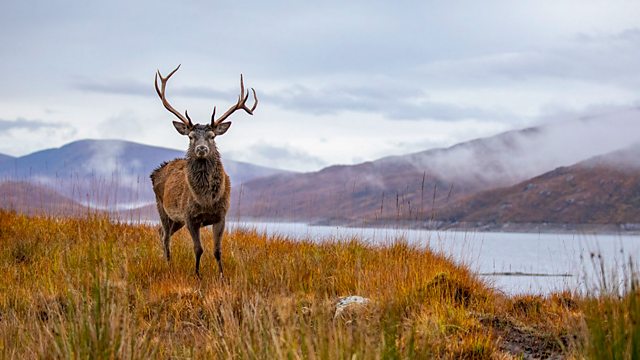Autumnwatch 2021 episode 1: Autumnwatch returns for a week of live wildlife stories from across the UK. Chris Packham and Michaela Strachan are at Wild Ken Hill in Norfolk to see what’s changed since spring and to revel in the Snettisham Spectacular – an autumn highlight in the birding calendar. In Northern Ireland, Gillian Burke digs deep into how moles cache worms for the cooler months, and Megan McCubbin is live from the Isle of Mull, a place famous for its eagles, red deer and otters.
Springwatch, Autumnwatch and Winterwatch, sometimes known collectively as The Watches, are annual BBC television series which chart the fortunes of British wildlife during the changing of the seasons in the United Kingdom. The programmes are broadcast live from locations around the country in a primetime evening slot on BBC Two. They require a crew of 100 and over 50 cameras, making them the BBC’s largest British outside broadcast events. Many of the cameras are hidden and operated remotely to record natural behaviour, for example, of birds in their nests and badgers outside their sett.
Springwatch begins on the Spring Bank Holiday and is broadcast four nights each week for three weeks. After the success of the first Springwatch in 2005, the BBC commissioned a one-off special, Autumnwatch, which became a full series in 2006. Winterwatch began in 2012, broadcast in January or February.
Autumnwatch 2021 episode 1
Isle of Mull
The Isle of Mull is a popular destination for naturalists and photographers for seeing some of Britain’s more elusive species. Mull has over 800 species of vascular plant (684 native and 171 naturalised) including 33 species of fern, at least 18 species of orchid and 22 native species of tree. There are about 700 species of lichen, 571 liverworts and mosses, and 247 marine algae (seaweeds), making a total of 2,388 species of plant recorded from the island. In addition, more than 2,000 species of fungi have been recorded on Mull: Dennis and Watling write, “When one speaks of the Inner Hebridean fungi one is referring to the floras of Mull and Rhum”.
The island has 261 different bird species, including the white-tailed eagle, which was reintroduced to the nearby island of Rùm and migrated to Mull, where it now has a stronghold. Basking sharks, minke whales, porpoises, and dolphins are among the sea life nearby.
The island is home to a population of otters that live in coastal habitat, hunting during the day. The Mull Otter Group was established for the conservation needs of otters on the Isle of Mull.
Eurasian otter
The Eurasian otter (Lutra lutra), also known as the European otter, Eurasian river otter, common otter, and Old World otter, is a semiaquatic mammal native to Eurasia. The most widely distributed member of the otter subfamily (Lutrinae) of the weasel family (Mustelidae), it is found in the waterways and coasts of Europe, many parts of Asia, and parts of northern Africa. The Eurasian otter has a diet mainly of fish, and is strongly territorial. It is endangered in some parts of its range, but is recovering in others.
The Eurasian otter is a typical species of the otter subfamily. Brown above and cream below, these long, slender creatures are well-equipped for their aquatic habits. Their bones show osteosclerosis, increasing their density to reduce buoyancy. This otter differs from the North American river otter by its shorter neck, broader visage, the greater space between the ears and its longer tail. However, the Eurasian otter is the only otter in much of its range, so it is rarely confused for any other animal. Normally, this species is 57 to 95 cm (22.5 to 37.5 in) long, not counting a tail of 35–45 cm (14–17.5 in). The female is shorter than the male. The otter’s average body weight is 7 to 12 kg (15 to 26 lb), although occasionally a large old male may reach up to 17 kg (37 lb). The record-sized specimen, reported by a reliable source but not verified, weighed over 24 kg (53 lb).
White-tailed eagle
The white-tailed eagle (Haliaeetus albicilla) is a very large species of sea eagle widely distributed across temperate Eurasia. Like all eagles, it is a member of the family Accipitridae (or accipitrids) which includes other diurnal raptors such as hawks, kites, and harriers. One of up to eleven members in the genus Haliaeetus, which are commonly called sea eagles, it is also referred to as the white-tailed sea-eagle. Sometimes, it is known as the ern or erne (depending on spelling by sources), gray sea eagle and Eurasian sea eagle.
While found across a very wide range, today breeding as far west as Greenland and Iceland across to as far east as Hokkaido, Japan, they are often scarce and very spottily distributed as a nesting species, mainly due to human activities. These have included habitat alterations and destruction of wetlands, about a hundred years of systematic persecution by humans (from the early 1800s to around World War II) followed by inadvertent poisonings and epidemics of nesting failures due to various manmade chemical pesticides and organic compounds, which have threatened eagles since roughly the 1950s and continue to be a potential concern. Due to this, the white-tailed eagle was considered endangered or extinct in several countries. However, some populations have recovered well due to some governmental protections and dedicated conservationists and naturalists protecting habitats and nesting sites and partially regulating poaching and pesticide usage, as well as careful reintroductions into parts of their former range.




